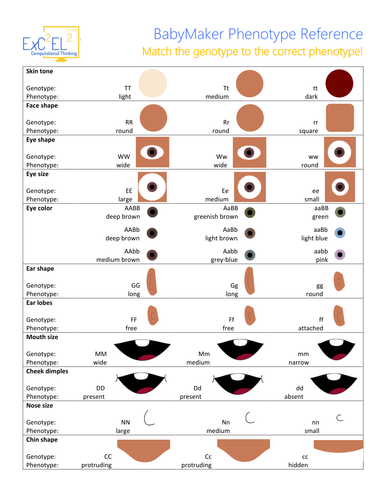

In the BabyMaker activity, students begin by identifying their own genetic traits, answering a series of questions about their facial features. As they input their phenotype, an animated cartoon representation of themselves as a baby is created. Students then randomly generate a second baby to “cross” with, and proceed to create new generations of babies by filling in Punnett Squares and by reading probabilities of expressed traits from Punnett Squares that are filled in for them. If they make a mistake, their babies might be missing a body part! This activity was heavily inspired by a paper-based activity from Cheryl Massengale.
For Google Docs links, please visit https://www.ctlessons.org/science/making-babies.html
This lesson is centered around my BabyMaker web app: https://www.ctlessons.org/apps/babymaker.html
Topics addressed:
Genetics – Punnett Squares, phenotypes, genotypes, traits, genomes
Primary CT concept: algorithmic thinking. To fill out a Punnett Square is to be the “computer” performing the correct algorithm, taking the input (the alleles of each baby) and creating the output (the probability matrix for the new baby’s trait).
Students will be able to:
Complete Punnett Squares given two sets of traits
Predict the likelihood of a trait being expressed given its Punnett Square
Prep:
This activity assumes your students have already been taught how to fill out and read Punnett Squares – it is a practice tool, not a teach-for-the-first-time tool.
Suggested lesson breakdown:
5min – walk through the activity end-to-end in front of your class, showing how they select their own traits and how they both fill out and read the Punnett Squares using the handout
25-40min – students work independently in BabyMaker. If students don’t finish all five generations of their baby before the end of class, they can easily submit their high score at any point, no matter how far they got. Encourage accuracy over speed!
For further information and relevant standards, please visit https://www.ctlessons.org/science/making-babies.html
Something went wrong, please try again later.
This resource hasn't been reviewed yet
To ensure quality for our reviews, only customers who have downloaded this resource can review it
Report this resourceto let us know if it violates our terms and conditions.
Our customer service team will review your report and will be in touch.